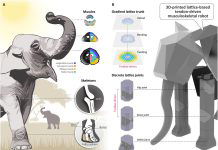
Researchers at The University of Texas at Austin have developed a groundbreaking stretchable electronic skin (e-skin) that could transform how robots interact with the world and with people.
Unlike existing e-skins that lose accuracy when stretched, this new version maintains its sensitivity, mimicking the softness and precision of human skin.
The development, led by Professor Nanshu Lu of the Cockrell School of Engineering, marks a significant leap in robotic technology, especially for applications requiring delicate touch.
Published in the journal Matter, this innovative technology addresses a critical challenge in the field of robotics: maintaining accurate sensing under physical strain.
Traditional electronic skins tend to misinterpret stretching as pressure, leading to errors in how much force a robot applies.
This can be problematic when robots are handling delicate tasks, like gripping a glass or touching a person.
Professor Lu explains that human skin is capable of stretching and bending without affecting its ability to sense pressure, a property that has now been replicated in the new e-skin.
“No matter how much our e-skin stretches, the pressure response doesn’t change, and that is a significant achievement,” she stated.
The potential applications of this technology are vast. In healthcare, robots equipped with this e-skin could perform tasks traditionally done by human caregivers, such as checking a patient’s pulse, helping with personal hygiene, or providing massages.
This is particularly important as the global population ages, and the demand for caregivers exceeds supply.
Furthermore, robots with sensitive e-skin could be deployed in disaster zones to assist in search and rescue operations, providing immediate medical actions like CPR to people trapped under debris without causing additional harm.
The e-skin works by sensing pressure from contact and informing the attached device about the necessary force for various actions, whether it’s securely holding a fragile object or interacting with a human.
The enhanced stretchability of the new e-skin allows it to perform a wide range of tactile tasks with high precision.
For instance, in tests, the e-skin equipped devices could accurately measure pulse waves on human subjects, hold a tumbler steady even as a coin was dropped into it, and gently press on a crispy taco shell without breaking it.
This advanced sensing ability is thanks to a hybrid response pressure sensor that combines capacitive and resistive responses, a technique refined over years by Lu and her team. Along with stretchable insulating and electrode materials, this hybrid sensor is the key to the e-skin’s high performance.
Professor Lu and her colleagues, including Roberto Martin-Martin from the Computer Science Department, are now working on integrating this e-skin into a robotic arm.
They have also filed a provisional patent and are exploring partnerships with robotics companies to commercialize the technology.
This e-skin could soon make robots more helpful and sensitive companions in our daily lives.



